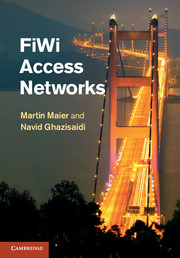Book contents
- Frontmatter
- Contents
- List of figures
- List of tables
- Preface
- Acknowledgments
- Part I Introduction
- Part II Fiber access networks
- Part III Wireless access networks
- Part IV FiWi access networks
- 10 RoF vs. R&F networks
- 11 Architectures
- 12 Network planning and reconfiguration
- 13 Techno-economic analysis
- 14 Network coding
- 15 Optical and wireless protection
- 16 Hierarchical frame aggregation
- 17 Routing and QoS continuity
- 18 Smart grid communications
- References
- Index
16 - Hierarchical frame aggregation
from Part IV - FiWi access networks
Published online by Cambridge University Press: 05 January 2012
- Frontmatter
- Contents
- List of figures
- List of tables
- Preface
- Acknowledgments
- Part I Introduction
- Part II Fiber access networks
- Part III Wireless access networks
- Part IV FiWi access networks
- 10 RoF vs. R&F networks
- 11 Architectures
- 12 Network planning and reconfiguration
- 13 Techno-economic analysis
- 14 Network coding
- 15 Optical and wireless protection
- 16 Hierarchical frame aggregation
- 17 Routing and QoS continuity
- 18 Smart grid communications
- References
- Index
Summary
We saw in Section 10.2 that significant progress has been made at the physical layer of fiber-wireless (FiWi) and in particular radio-over-fiber (RoF) networks. However, state-of-the-art radio-and-fiber (R&F) networks integrating Ethernet passive optical networks (EPONs) with a wireless local area network (WLAN)-based wireless mesh network (WMN) (see Fig. 10.4) suffer from a poor quality of video transmissions that sharply deteriorates for an increasing number of wireless hops. Therefore, a more involved investigation of the performance of integrated EPON/WLAN-based WMN networks, especially in the wireless segment, is needed.
In this chapter, we propose and investigate a FiWi network architecture that converges next-generation WLAN-based WMN and EPON networks. The considered FiWi network architecture enables existent EPON networks to be upgraded with wireless extensions in a pay-as-you-grow manner while providing backward compatibility with legacy infrastructure and protecting previous investment. Furthermore, the benefits of extending advanced frame aggregation techniques to EPON and their integrated operation across both optical and wireless segments are investigated. For more detailed information the interested reader is referred to (Ghazisaidi et al. [2010], Ghazisaidi and Maier [2011]).
Integration of next-generation WLAN and EPON
Figure 16.1 depicts our proposed network architecture and node structures for integrating a next-generation WLAN-based WMN with an EPON network. In this figure, an ONU represents a conventional EPON optical network unit (ONU), as described in Chapter 4. Some of the ONUs are upgraded with a mesh portal point (MPP) to interface with the WMN.
- Type
- Chapter
- Information
- FiWi Access Networks , pp. 187 - 195Publisher: Cambridge University PressPrint publication year: 2011



